2012: Establishing St. Helen’s Community Garden
Nestled between the Glebe Library and the St. Helen’s Community Centre lay an underutilized space—a patch of grass with a solitary tree. In the year 2012, sparked by the vision of two passionate women from Glebe, an idea took root: to cultivate a thriving community food garden. This marked the genesis of a decade-long journey, where a dedicated group of individuals converged with a shared dream, collaborating with the council to shape the vibrant garden that stands today.


Origins and Inception
The genesis was humble. In May 2012, leaflets circulated, beckoning locals to gather at the St. Helen’s Community Centre. Twenty eager souls answered the call, igniting discussions that birthed the notion of a Community Garden. With swift support from a Sydney City Councillor, the wheels were set in motion. Two coordinators emerged, charged with presenting the proposal to the Council. Subsequently, a formal application for a Community Matching Grant and a comprehensive Garden Management Plan found their way to the Council desks, marking the initial steps toward realisation.
Navigating Challenges and Progress
The journey was not without its hurdles. Council engagement, necessitated by the grant application, ensued a series of consultations and deliberations. Meetings with the Council’s Volunteers and Community Gardens officer culminated in the engagement of a design consultant. Safety, compliance, and accessibility were key considerations in crafting a design that saw the light of public scrutiny in August. Approval followed, albeit not without a minor public objection, which was amicably resolved in favour of transplanting a tree.
Progress crawled amid the departure of some disillusioned members. Yet, in December 2013, the first tangible fruits emerged—four timber garden beds, meticulously constructed offsite and seamlessly assembled in place. These beds became the nurturing ground for the inaugural vegetable seeds, emphasizing the garden’s ethos of fostering organic, heirloom varieties through sustainable practices.
Evolution and Expansion
In subsequent years, milestones adorned the garden’s timeline. 2014 saw the blessing for a small garden shed, swiftly succeeded by the erection of 12 more beds, a feat accomplished by the council in a mere three weeks. A grant of $10,000 in 2015 fuelled further growth, giving rise to the ‘Secret Garden’ and the ‘Kitchen Garden,’ enriching the garden’s diverse landscape.
Present Operation and Future Prospects
Today, the garden thrives as a volunteer-led initiative, governed by an elected committee ensuring transparency and accountability. Annual General Meetings serve as checkpoints for activities and funds. While sustained by membership fees and donations, the garden’s sustainability hinges on periodic council grants for major endeavours.
The journey continues, as renewal becomes inevitable. As the garden blooms and evolves, it remains a testament to the collective vision, resilience, and community spirit that birthed its existence.
2013: A Year of Evolution
May 13: Design Evolution and Consultation and Meeting with Aspect Studios
Council embarked on a pivotal journey by engaging Aspect Studios to design the envisioned garden. Collaborative efforts with members led to significant alterations in the initial plan. The Plan of Management underwent revisions, guided by the insights of Council coordinator Raewyn Broadfoot.


In July and August, the culmination of efforts resulted in the finalization of the garden design, showcased in a public exhibition. Council conducted a comprehensive consultation, reaching out to 3000 residents and businesses, soliciting community feedback for the proposed development at 184 Glebe Point Road. Subsequently, the final Plan of Management was unveiled by the council, drawing in 36 submissions—30 in support, 3 conditional endorsements, and 3 in opposition.
Insert Image: Garden Design on Public Exhibition
Approval and Incremental Development
The Sydney City’s Environment and Heritage Committee convened to deliberate on a report advocating the approval of the garden design. Advocates Natasha and Michael lent their support, propelling the design’s endorsement. The project was slated for development in five stages, aligning with available funding, community support, and the demonstrated demand for expanded garden space. Responding to the initial grant’s shortfall, the garden secured an additional $20,000 earmarked for Stage 1.
September: Budgeting and Strategic Meetings
In a crucial September meeting, six members engaged with Raewyn to discuss budgetary allocations, material procurement, and the removal of an old stump. Further discussions transpired in November, with nine members convening alongside Raewyn and Dave Brodie, Parks Service Manager, to secure approval for assembling prefabricated beds. This led to the birth of today’s beds 1A, 1B, 2A, and 2B, carefully assembled by hand tools under the supervision of a certified landscaper.
December: Culmination of Efforts
December saw the fruition of meticulous planning and teamwork. Seven members convened to finalize bed designs, landscaping directives, and Occupational Health and Safety (OHS) training for participating gardeners.





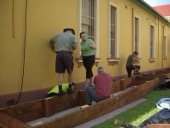


December
Sawing timber in Church Lane with Jock, Michael, and Tim. Planks were cut, drilled, and assembled, then transported to the garden. Beds 1A, 1B, 2A, 2B took shape along the concrete path beside St. Helen’s Community Centre. Bed 1A was transformed into a wicking bed, eventually filled with soil and the inaugural seedlings. Assembling garden beds, lining the wicking bed, laying down piping, completing bed frames, and filling beds marked a momentous achievement for the year.

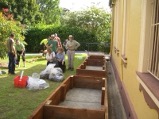
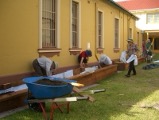
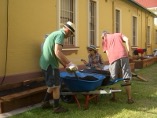

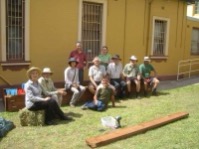

2014: Blossoming Developments
January: Planning and Permissions
A gathering of eleven members, alongside Raewyn, convened to deliberate on installing a concrete slab for a small garden shed. February marked the confirmation to proceed with this venture.
INSERT PHOTO OF GARDEN SHED
February: Wicking Barrels and Natasha’s Contributions
The month witnessed the installation of three wicking barrels adjacent to beds 1 & 2. Natasha played a pivotal role in the completion of one of these wicking barrels.



March: Community Engagement through Plant Giveaway
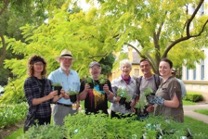
A plant giveaway day in March fostered community engagement, offering a platform for sharing and nurturing greenery.
May 12: Unveiling the Secret Garden
Council orchestrated the removal of the Camphor Laurel stump and a small tree, paving the way for contractors to actualize the remaining 12 planned beds. This transformative endeavour culminated in the completion of the project within an impressive three-week timeframe.




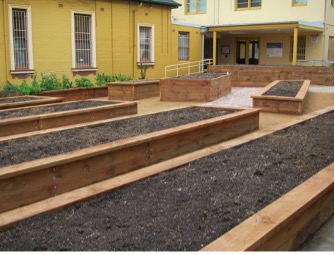
June: Sowing the Seeds of Growth
Michael and Janine took to planting strawberries in the newly constructed beds, symbolizing the germination of fresh beginnings within the garden’s landscape.


December: Flourishing Garden
The year ended with the garden in full bloom, showcasing an impressive surge in growth and vibrancy.
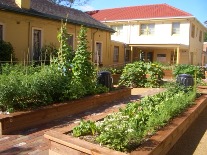


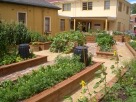

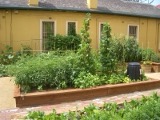

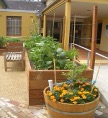
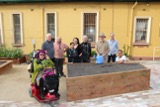

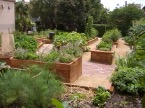








2015: Growth, Partnerships, and Flourishing Community Engagement
The wheels of progress continued to turn for St. Helen’s Community Garden in 2015, marked by fruitful partnerships, bountiful harvests, and expanding horizons.
Expanding Horizons: Grant Awards and Garden Development
The garden committee embarked on an ambitious journey, applying for, and successfully securing another Council Community Grant worth $10,000. The expansion project introduced two distinct areas: the enchantingly named “Secret Garden,” nestled on the opposite side of St. Helen’s Community Centre, and the “Kitchen Garden,” adjacent to the rear carpark. August witnessed the initial clearing of the Secret Garden by the council, initiating the groundwork with the creation of several new beds. Subsequently, an application for another Community Matching Grant was tendered in September, earmarked for the development of stages 2 and 3 across both the Kitchen and Secret Gardens.




Hand painted signage thanks to the wonderful and artistic gardener, Louise Graber.
Our produce is so very tempting to the public! It’s a sad truth that illicit picking happens and therefore we try to be polite about it.




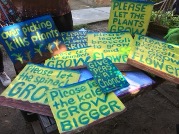

The yarn bombers
Culinary Delights: Collaborative Events and Celebrations
An exciting collaboration with a boutique winery, Cake Wines, materialized in the form of a luncheon event, celebrating locally sourced produce alongside a variety harvested from the garden. The event, approved by the garden committee, took place on a memorable Sunday, November 7, 2015, fostering a delightful fusion of flavours and community camaraderie.
Cultivating Community Outreach: Cancer Prevention and Healthy Eating Initiatives
The garden’s reputation as a hub for fresh, nutritious produce caught the attention of esteemed organizations like the Cancer Council of Australia and OzHarvest. Requests poured in for participation in events spotlighting the significance of fruits and vegetables in disease prevention and healthy eating workshops. The committee enthusiastically embraced these collaborations, extending their commitment to community well-being.
Innovative Solutions and Triumph over Challenges
October posed a challenge with slaters posing a threat to the seedlings. Michael, in a stroke of ingenuity, devised a “slater smoothie.” Surprisingly effective, this novel concoction helped deter the slaters, demonstrating the power of innovation in overcoming obstacles.
Triumphant Endings and Celebrations
November brought glad tidings from the council, as news arrived of the garden’s successful recommendation to receive a $10,000 grant from the previous application. To cap off the year’s accomplishments, an end-of-year picnic held within the garden’s lush confines saw jubilation and merriment, complemented by the gratifying announcement from Mayor Clover Moore confirming the grant’s approval.
2016: Continuing Community Engagement and Celebrations
As the new year unfurled, St. Helen’s Community Garden prepared to embrace another chapter of growth, camaraderie, and contributions to the community.


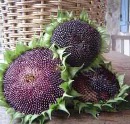
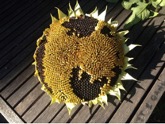
February brought with it an esteemed honour for the volunteers of the garden. Clover Moore, the Mayor of Sydney, hosted an annual reception, extending appreciation for the invaluable contributions of all volunteer groups. This recognition served as a testament to the dedication and efforts invested by the collective.
A Recognition of Volunteers: Mayor’s Reception

March: Cultivating Bounty and Individual Spotlight
Amidst the garden’s verdant tapestry, Jock, a pivotal figure in the garden’s evolution, proudly presented the Turks head squash, emblematic of the fruitful endeavours within. July marked a significant milestone—the first planting in the kitchen garden, signalling a promising phase of cultivation.



Community Support: Grill’d Restaurant’s Generosity
May witnessed a heartening gesture from Grill’d restaurant, exemplifying community support with a generous donation of $300 as part of the “Grill’d Local Matters” promotion. This act of kindness served as a testament to the garden’s resonance within the local community.
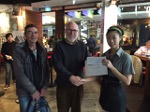
December: Culmination of Efforts in the Kitchen Garden
The year concluded on a high note as the kitchen garden burgeoned with life, symbolizing the culmination of dedicated efforts and meticulous planning throughout the year.




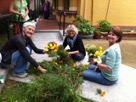

2017: A Year of Flourishing Growth and Community Celebrations
As the sun painted the sky in vibrant hues, St. Helen’s Community Garden welcomed the new year with the stunning display of lovely red okra flowers, signalling a year that promised growth, abundance, and community engagement.


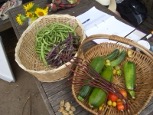
okra flower.
February: Collective Efforts and Green Fruits and a working bee
A call echoed through the community—scheduled for the 18th and 19th, beckoning volunteers to join hands. With contractors wrapping up their work in the Secret Garden, plans unfolded for a delivery of 3 cubic meters of “complete vegetable and seedling mix.” The parking lot transformed into a temporary storage ground as the soil awaited its transfer to the garden beds. Okra, rhubarb, basil, chillies, zucchini, and eggplants adorned the harvest baskets, while diligent efforts continued with a second spray of Eco-oil on citrus trees and the thoughtful transplantation of silver beet and parsley. Richard and his team crafted a bamboo platform, an innovative stage for cucumber growth.






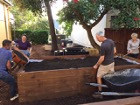

March-April: Nature’s Splendour Unfolds
Jerusalem Artichokes and Pineapple sage graced the garden, but stealing the spotlight was the Red Army Paw Paw. Planted just the previous October, this resilient plant flourished in the Kitchen Garden, bearing testament to its tenacity with flowers and red-fleshed fruits. Comfrey, eggplant, and Yakon flowers added their charm to the vibrant tapestry of the garden.

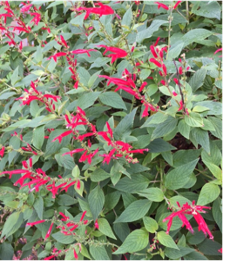

Jerusalem Artichoke, Pineapple sage and Paw Paw.



Comfrey, Eggplant and Yakon flowers
May-June: Celebrating Milestones and Humble Contributions
The Garden rejoiced in its 5th Anniversary with an Open Day on May 20th, inviting the community to celebrate its journey. Amidst the festivities, attention turned to the tomatillo—a humble, albeit less favoured, yet consistently productive plant, brimming with Mexican husk tomatoes.
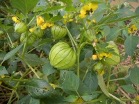
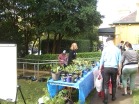


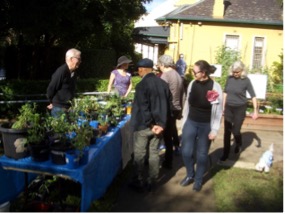



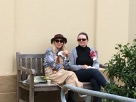
July-September: Initiatives and Bountiful Harvests
A Bizzy July brought an innovative addition—a ‘bee motel,’ a thoughtful donation from Weleda as part of a school initiative, fostering a hospitable environment for pollinators.



October, Costa came to visit. The episode aired on Gardening Australia on 23 February 2018






If you’d like to watch the episode, click this link:
https://www.abc.net.au/gardening/how-to/sharing-the-steet/9525430
November saw the fruitful culmination of the year’s labour as the garden celebrated abundant potato harvests, a testament to nurturing patience and dedication. The year ended on a celebratory note with the December Solstice Party, encapsulating the spirit of joy and community bonding.
2018: A Year of Harvest, Artistry, and Celebrations
The sun-drenched gardens of St. Helen’s Community Garden flourished with life and activity throughout the year, nurturing not only vibrant vegetation but also fostering a spirit of community engagement and artistic endeavours.
January: A Bountiful Harvest Despite the Heat
The scorching heat of January didn’t deter the gardeners; 17 dedicated members watered, distributed nourishing worm tea, and reaped the rewards of their labour. The harvest included a medley of okra, tomatoes, beans, cucumbers, pepinos, and an array of greens. Amongst the bountiful harvest, sunflowers bloomed, and corn began to set its cobs, promising further abundance.
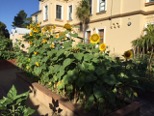
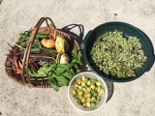
February-March: Celebrating Diversity in Produce
Eggplants graced the garden, presenting a diverse array of flavours and colours— ‘Rosa Bianca,’ plump and white, blushed with lavender hues, alongside the striped elegance of ‘Listada Di Gandia,’ while the ‘Golden Egg’ variety added its golden touch. The Makrut lime and lovely lemons thrived, enhancing the garden’s citrus tapestry. The ‘Jalapeno’ chilli pepper, mild yet flavourful, made its mark on the Scoville scale, while the community revelled in the joy of harvesting.
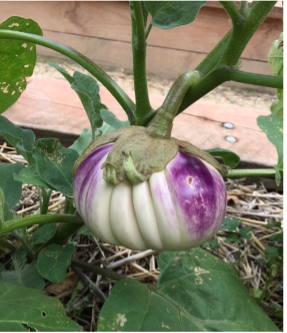


Eggplants left photo is of our ‘Rosa Bianca’, a plump, squat white fruit blushed with lavender while the right photo is of our ‘Listada Di Gandia’, a smooth, shiny purple and white striped fruit. Golden Egg’ aubergine on the right.
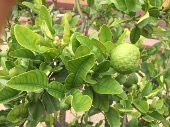
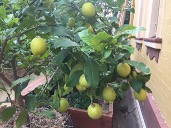
Makrut lime (C. hysrtix) and lovely lemons
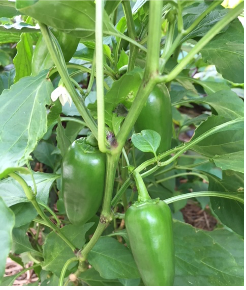
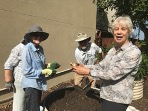
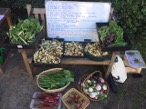
Our ‘Jalapeno’ chilli is producing mild green fruit now that would be about 1,000 on the Scoville scale (Tabasco sauce is 5,000). In 1912 Wilbur Scoville devised a “hotness” scale for capsaicin, the ‘hot’ chemical in chillies.
June: Embracing Community and Creative Pursuits
The Winter Solstice Party brought together the garden’s community, enveloping all in a cheerful celebration of the season, fostering bonds and camaraderie. Meanwhile, the garden played host to Costa, filming for an ABC TV feature on ‘Get Grubby,’ showcasing the garden’s vibrancy and community spirit.



September-October: Innovations and Artistry Unveiled



Carrots Beetroot Green and more greens
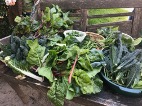

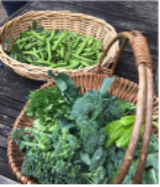
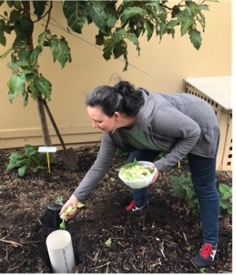
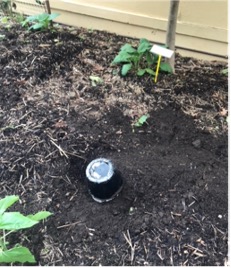
“Worm Tower”.
Innovations sprouted in the garden, notably the introduction of the ‘Worm Tower,’ a simple yet effective addition facilitating the nourishment of plants through composting. The garden’s creative spirit bloomed further with a new art installation designed and constructed by the talented team of Julie, Colin, and Peter—a dual-purpose structure serving as both art and support for cucumbers.
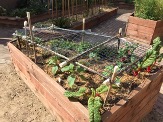
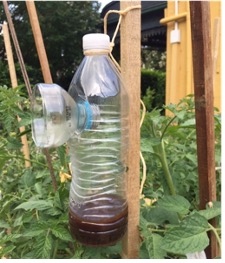
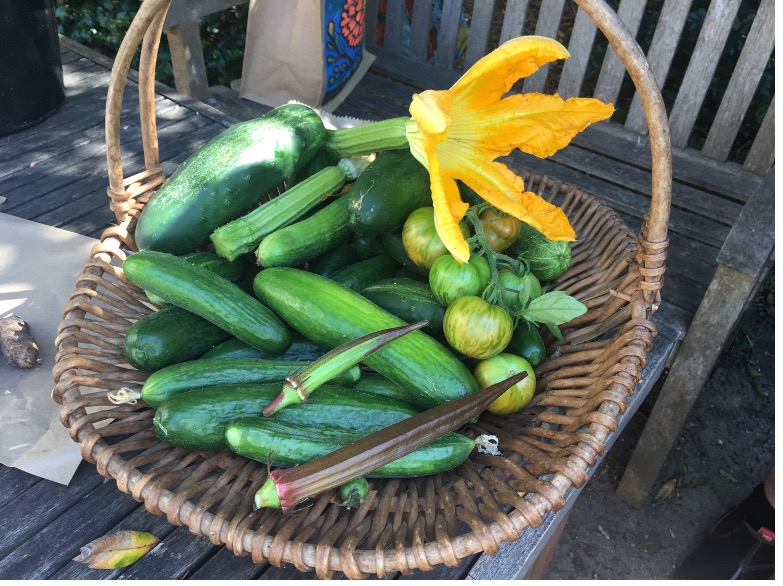
Cucumber Frame Flytrap Zucchini harvest
December: Storms and Celebrations
As storms loomed threateningly, the Summer Solstice Party was a joyous and tranquil affair, where members and families gathered, savouring the fruits of their labour—homegrown zucchinis, cucumbers, radishes, pepinos, garlic, and herbs. Glen from the Kil.n.it pottery collective contributed a beautiful ceramic cap for a tomato stake, appreciating the garden’s tranquillity and providing inspiration for creativity. Lucy created an innovative flytrap with vegemite in the solution. The year ended on a note of whimsy, capturing the essence of van Gogh’s delight.

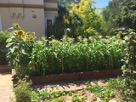
2019: A Year of Bountiful Harvests, Workshops, and Celebrations
January: Abundant Harvests Welcome the Year
St. Helen’s Community Garden welcomed the new year with a cornucopia of harvests, setting the tone for a year of flourishing produce and community engagement.


February-April: Diverse Flora Unveiled
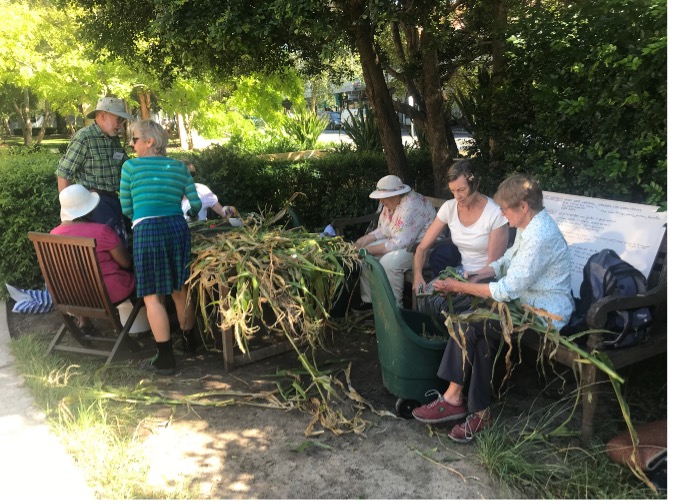
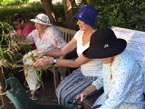
As February rolled in, the gardeners were engaged in the process of recycling cornstalks while discovering the fascinating Angled Luffa, known for its various names and versatility in the culinary world. April brought forth green papayas and the aromatic Mexican Tarragon, painting the garden in a spectrum of colours and scents.
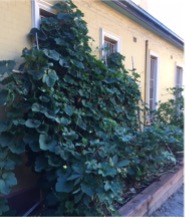
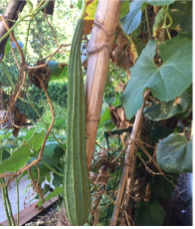
Angled Luffa (Luffa acutangula, Family Cucurbitaceae or gourd/cucumber family) also known as Okra Vine, Okra Cee Gwa or vegetable gourd.

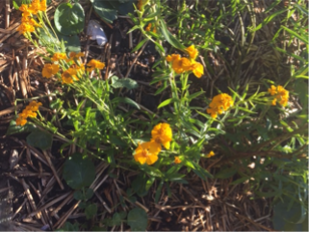
Green papayas and Mexican Tarragon
May marked a flourishing Jerusalem artichoke harvest, showcasing the garden’s bounty. The Winter Solstice party in June brought the community together, fostering bonds and merriment amidst the flourishing greenery.
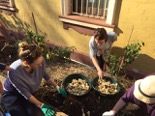
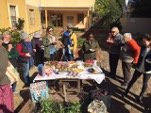
Jerusalem artichoke harvest Winter Solstice party
July-August: The Joys of Harvest and Learning
The garden continued to yield an array of produce—Jerusalem artichokes, beetroot, broccoli, radishes, kale varieties, lettuce, sorrel, parsley, and a myriad of mustard greens. The arrival of the first cauliflowers, resplendent in their lime green hue, marked a milestone from seeds sown in March. August saw the growth of broad beans and the enchanting sight of finger limes adorned with blossoms and bustling bees.
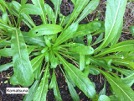
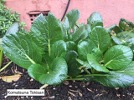





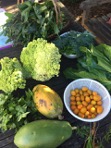


Broad bean or fava bean (Vicia faba) Finger lime covered in flowers and bees.
September-October: Guided Tours and Garden Visitors
The garden welcomed visitors from the National Parks Association, impressing them with its diverse plant varieties and intriguing worm farms.


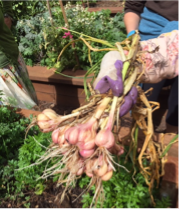
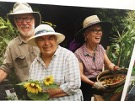
Great garlic Glenlarge and Italian Pink
Judith led a group of thirteen members of the National Parks Association through our garden. They were impressed with the variety of plants and particularly interested in our worm farms.
October, Costa came to visit. The episode aired on Gardening Australia on 23 February 2018
https://www.abc.net.au/gardening/how-to/sharing-the-steet/9525430






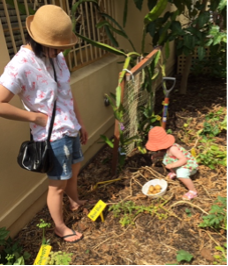
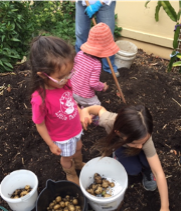
Nicola Dutch cream king Edward potato varieties
November-December: Workshops and Summer Celebrations
November brought an exciting addition—the arrival of a Native Beehive, accompanied by a captivating workshop conducted by Tim Heard. Members tasted pollen, honey, and propolis, delving into the intricate world of native bees. Black chillies adorned the garden, adding a touch of spice amidst the summer garden’s resplendence. The year culminated in a joyful Summer Solstice Party, where the community revelled in homegrown delights despite the challenges of drought.
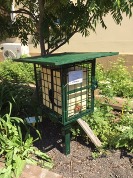
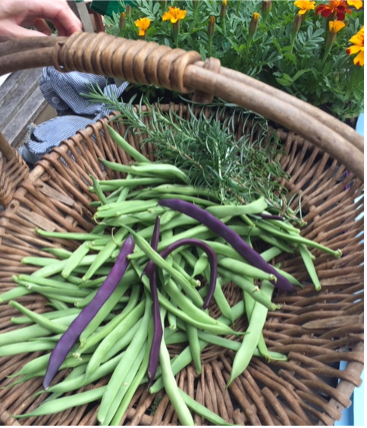
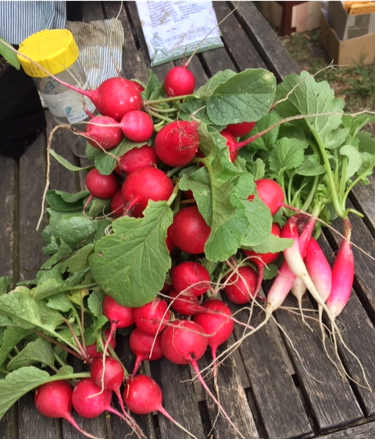
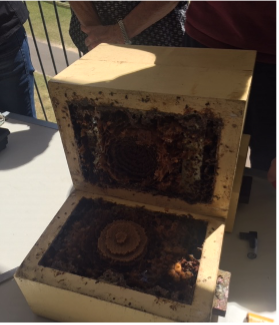

Seven members attended the bee workshop on Saturday. Tim Heard, renowned expert on bees, gave a fascinating talk on both the European honeybee and our native bees. He has published the definitive book on the subject: “The Australian Native Bee Book”. The workshop also involved splitting an active hive (see photos below). We tasted pollen and honey from the hive along with the propolis (a mixture of wax and plant resin the bees use to make the cells and pots). The centre of the photo shows the brood cells surrounded by an open structure for ventilation. There are pots on the right filled with yellow pollen and pots on the left filled with honey.
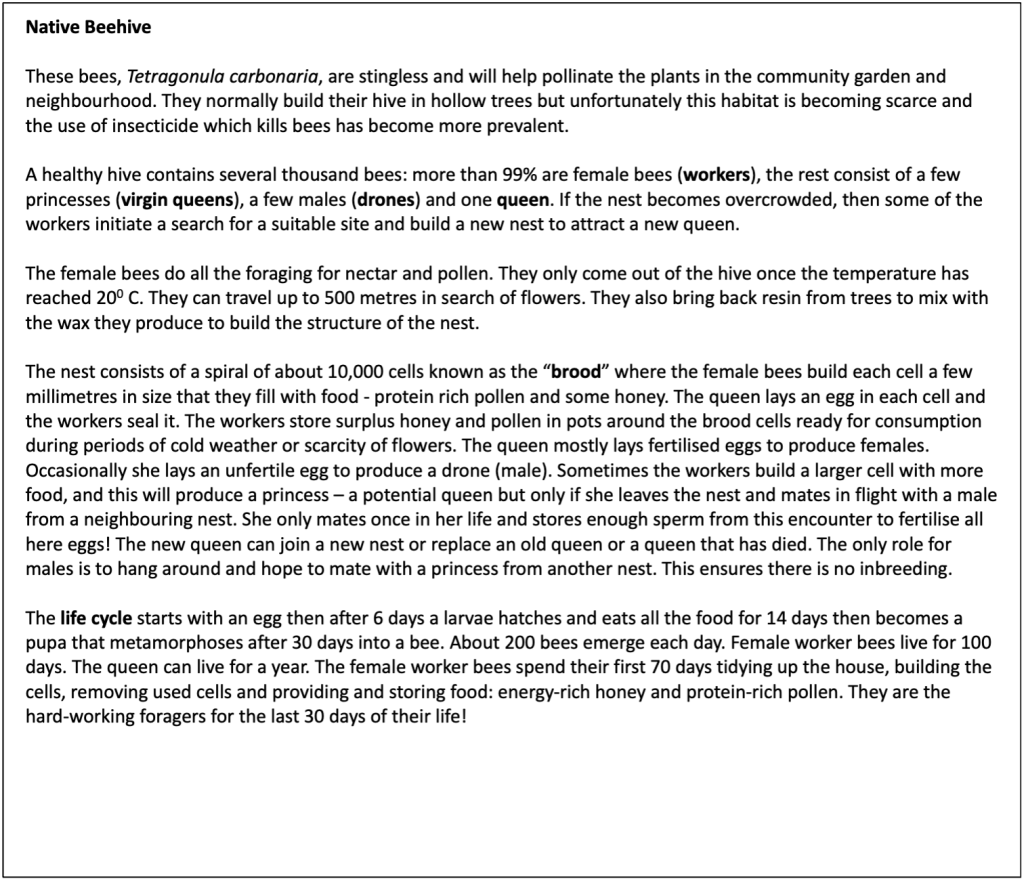
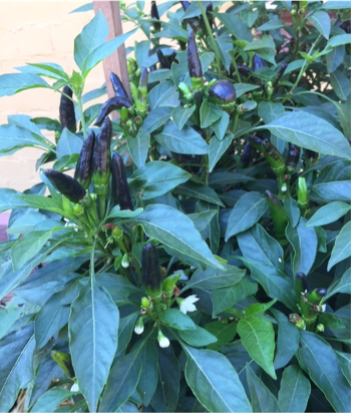
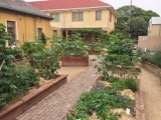
Black chillies and the summer garden are looking fantastic despite the drought.
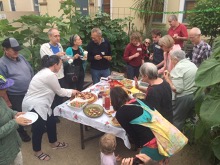
December Summer Solstice Party
Hello 2020: A Year of Resilience and Global Connections
New Years’ Day



January-February: Dragonfruit Splendour and International Visitors
The year commenced with the garden witnessing the awe-inspiring beauty of Dragonfruit in February, its flourish highlighted by vibrant red fruits. Despite soaring temperatures that challenged the garden’s resilience, the lovely sunflowers stood tall, offering a ray of delight. The garden welcomed visitors from Tokyo, inspiring them with the essence of community gardening.

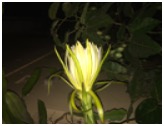

The Dragonfruit in Feb followed by the spectacular flourish of red fruit.
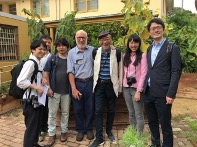
Visitors from Tokyo learning about our community garden
“Dear Jock
It was really good experience for us to have time with you, feeling good atmosphere of your garden and learning a lot about managing a community garden.
It is very respectful activity; we would like to create garden in the near future in Tokyo.”

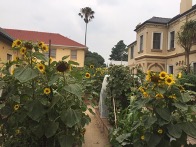
Very high temperatures left the garden struggling but the lovely sunflowers were a delight.
March-April: Botanical Beauty and Garden Enhancements
March brought forth the allure of wild chicory and the blossoming Okra and Rosella flowers, painting the garden with hues of nature’s artistry. Gratitude was extended to Tim for his contribution—a netted bed protecting brassicas from the white butterfly attack. The garden flourished amidst the emergence of the Swallow butterfly, blue borage attracting bees, and the meticulous shed clean-out. New signage illuminated the garden’s inner workings, while a Ladies Turmeric Harvest Fest in June celebrated the season’s bounty.
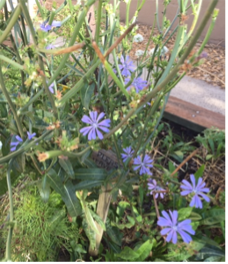
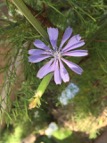
Wild chicory
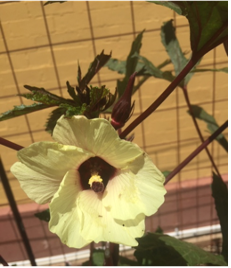
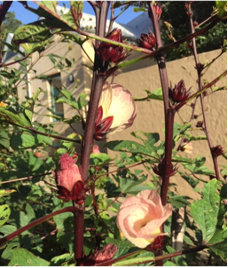

Okra flower Rosella flowers Red Calyx of the rosella flower

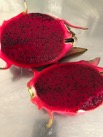
Dragon Fruit


Thank you, Tim, for the netted bed in the secret garden. It will protect the brassicas from white butterfly attack.

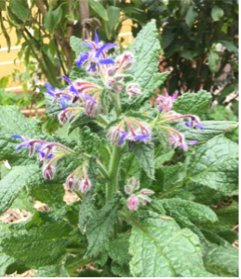

Swallow/ orchid butterfly on a turmeric plant and blue borage, a bee’s favourite and a garden harvest salad

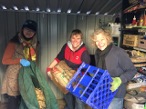
New signage explaining how our garden works. Shed clean out.
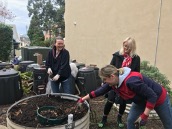

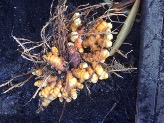


It’s a June Ladies Turmeric Harvest Fest
Spring Celebrations and Equinox Gatherings
The Kitchen Garden witnessed the festivities of spring planting, showcasing the resilience and vibrancy of Mibuna, Miner’s lettuce, and Finger lime in full bloom. September’s Spring Equinox morning tea captured the spirit of celebration amid a bumper harvest, setting the stage for communal enjoyment. Devi, an embodiment of dedication, tended the garden even in the rain, embodying the garden’s unwavering commitment.


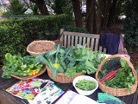
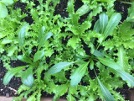
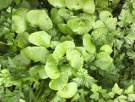
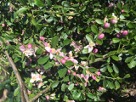
Mibuna with curly endive Miner’s lettuce Finger lime in full flower



Calendula/ marigold Cosmos Viola tricolour

Spring Equinox morning tea- note the bumper harvest.
November-December: Harvests and the Impact of Covid-19
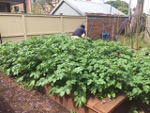

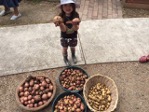
December marked the annual Potato Harvest, a celebration of collective effort and the rewards of labour. However, the Summer Solstice Party was cancelled due to the global impact of Covid-19, requiring caution and prioritizing safety. Globe artichokes added their unique charm to the garden, a testament to nature’s versatility and resilience.
2021: A Year of Celebrations, Challenges, and Commemorations
January-February: Floral Splendour and Special Celebrations
The year commenced with the graceful bloom of the Globe Artichoke flower, setting a picturesque backdrop. February saw the garden adorned with love as Eva and Tim celebrated their wedding, capturing timeless memories amid the greenery.
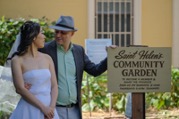
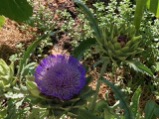
March-April: Culinary Delights and Community Contributions
March brought forth a delightful morning tea arranged by Natasha, featuring a beautiful cake adorned with edible flowers, dragonfruit, and tamarillos. April showcased the Rosella blooms and the aromatic essence of Mexican tarragon, enticing gardeners’ senses.
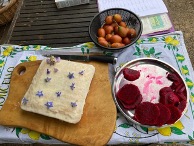
Thank you, Natasha, for a beautiful cake decorated with our edible flowers. With sliced dragonfruit and a bowl of tamarillos, make for a decadent morning tea.





April Rosella (Hibiscus sp). Mexican tarragon
May-June: Cosmopolitan Fairies and Artistic Gestures
May witnessed the charming arrival of the Cosmos Fairies, adding enchantment to the garden’s ambiance. Judith’s carrot cake accompanied by exotic combinations of dragonfruit, and finger limes brought a unique culinary experience. A local potter’s gesture of replacing a missing worm tower lid with a ceramic version added artistic flair to the garden’s functionality.



It may only be a small thing but thank you to a local potter for replacing a missing worm tower lid with a gorgeous ceramic version.

Thanks to Judith for bringing a carrot cake for morning tea served with the dragon fruit and finger limes! An unusual but delicious meeting of flavours.
July-September: Navigating Lockdown and Garden Essentials
Despite the challenges posed by the lockdown from July to September, the garden persevered, ensuring essential tasks were completed in adherence to council guidelines. There were limited garden meetings, but all the essentials were being carried out as per council guidelines.




Flowering brassica broadbeans


Note the bumper crop! Colourful display to cheer us up. Thanks to the yarn bombers.
October-December: Eased Restrictions and Commemorative Reflections
As COVID restrictions eased, normal garden meetings resumed, welcoming the return to regular activities. In the latter months, the garden celebrated the abundance of produce, showcasing a diverse range of fruits, vegetables, and tubers.



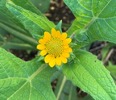
Jerusalem artichoke (Helianthus tuberosus) Ginger (Zingiber officinale) Yacon (Smallanthus sonchifolius) also known as Peruvian ground apple.
Loan’s Green Papaya Salad. Thank you.
500 g green papaya, peeled, seeded, finely shredded (1mm). Soak in cold water with juice from half of a lemon for 10 minutes (just enough liquid to cover). Then drain.
200 g cooked (boiled) pork belly or lean pork, cut into thin slices (approx. 2mm thick)
10 medium prawns, cooked, peeled, cut in halves lengthwise
100 g coarsely ground, freshly roasted peanuts.
For the sauce:
2 tablespoons of good fish sauce
2 tablespoons of white sugar
2 tablespoons of lemon juice
1 red hot chilli, seeded and finely chopped 1/2 teaspoon of mince garlic.
Mixed chopped herbs: Vietnamese mint, mint, coriander. Roughly chopped.
Combine all sauce ingredients in a bowl and toss over pork and prawns for 10 minutes, then mix with papaya. Before serving, sprinkle peanuts and mixed chopped herbs.




Beetroot, choko and potato varieties King Edward, Purple Congo, Dutch Cream, Kipflers and Royal Blue
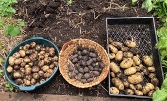






Australian Museum: City of Sydney informed us that a photo of our garden is in a rolling display of photos in the exhibition called “Spark” at the Australian Museum.
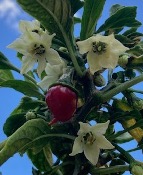
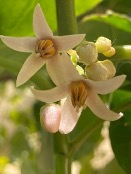




Cape gooseberry/Husk Cherry Physalis peruviana frutescens. Eggplant/aubergine/brinjal Solanum melongena Pepino/melon pear Solanum
Our dragon fruit cactus (Hylocereus costaricensis) is enjoying its position against the warm north wall of the community centre as it clings to the wall and peeps through the second storey window.

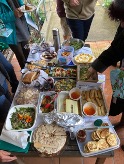
Summer solstice celebration
Commemoration and Reflection
The year concluded on a bittersweet note, acknowledging the passing of Mira Crouch, a founding member known for her remarkable life journey and contributions. A WW2 Survivor, an academic, author, music, and garden lover. Her legacy resonates within the garden’s community, serving as a tribute to resilience and strength.
A Journey Through 2022
January: Blossoms and Galangal
The new year opened with a picturesque display of flowers and fruits, setting the stage for a vibrant beginning.









Dragon Fruit flower rich red fruit tomato varieties Galangal and Turmeric
February: Generosity Amidst Adversity
Amidst challenges, the gardeners experienced an act of kindness as a new table was kindly donated by members, showcasing the spirit of the gardening community. Plans were laid for the introduction of four raised garden beds in the Secret Garden, fostering anticipation for expansion.

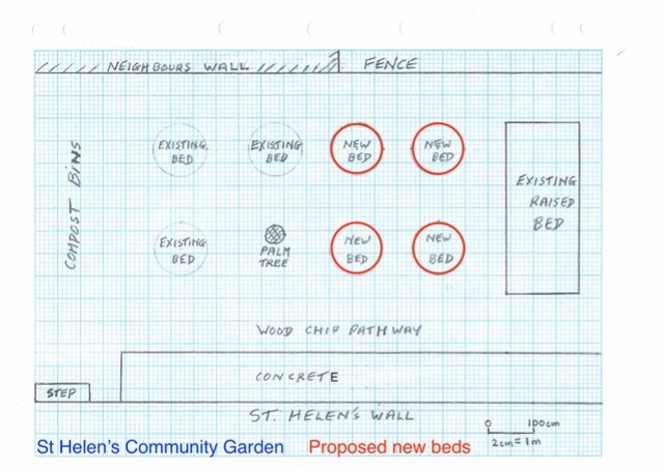
February: Table thief has struck! Plan for 4 new raised garden beds for the Secret Garden.
April: Floral Beauty and Unfortunate Incidents


The garden exuded beauty with Eggplant and Pepino blossoms. Unfortunately, a stolen mandarin tree became the talk of the garden community, drawing both empathy and support after the brazen theft was captured on CCTV.
May- June: Busy Days and Nature’s Drama
The garden buzzed with activity as dedicated members tirelessly tended to its needs. Amidst the garden chores, a captivating scene captured by Peter, a moment of nature’s drama, showcasing a wasp and a huntsman in action. Not everyone’s cup of tea but here’s a beautifully snapped picture, Who’s the hunter now?

Wasp catching a huntsman.

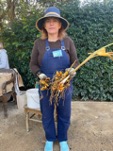
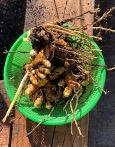
Tumeric time

“Two relatively uncommon leaf greens are appearing in the greengrocers at the moment, popular in Mediterranean diets. They are turnip tops (Cima di Rapa, Brassica rapa ssp. sylvestris) and leaf broccoli (Spigariello, Brassica oleracea cv. ‘Liscia’). We are harvesting them at the moment, both Italian heirloom varieties – see photo above. “
Council contractors carefully refurbished paths, employing gravel and bark mulch, and rejuvenated the raised beds, enhancing the garden’s infrastructure.




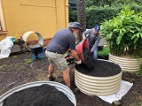
A diligent team at work
July-August: Data and Natural Encounters
Michael’s meticulous recording of rainfall data for seven years was transformed into insightful graphs by Jock. The garden’s biannual Winter Solstice Feast brought everyone together, celebrating the changing seasons and abundance.
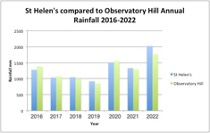

September December -: Bountiful Harvests Festivities and Natural Wonders

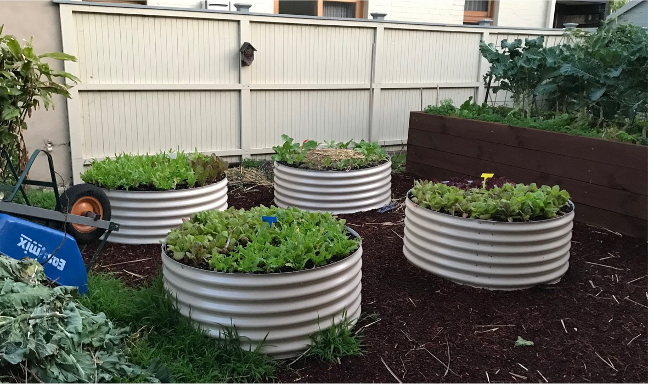
the garden boasted a myriad of potato varieties like Purple Congo, Dutch Cream, Sebago, King Edward, and Red Pontiac.



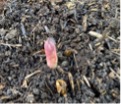
It might not look like much but it’s a sprouting asparagus spear.
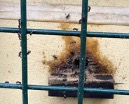
Nature showcased its resilience as bees returned after a harsh winter.

After the recent rain, no watering needed to be done. We applied the usual worm farm juice, tidied up some beds, weeded beds and paths and collected a decent harvest of silverbeet, lettuce (Lollo Rossa, Rouge d’Hiver, Green Cos, Royal Oakleaf, Freckles), celtuce, celery, radish, asparagus, parsley, sage (no rosemary or thyme!) and the last of the broccoli.
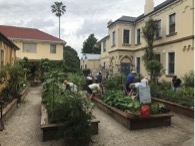
Hands in the earth (Credit: Floris, USyd)

The vibrant ecosystem of worms in compost bins thrived, symbolizing the garden’s health.


Thanks Kil.n.it Potters, who operate at the rear of the garden, for the lovely ceramic labels!




Papaya flowers, Cucumber flowers: female (left) with ovary, that will turn into fruit, male (right) with thin flower stalk. Bean and cucumber harvest
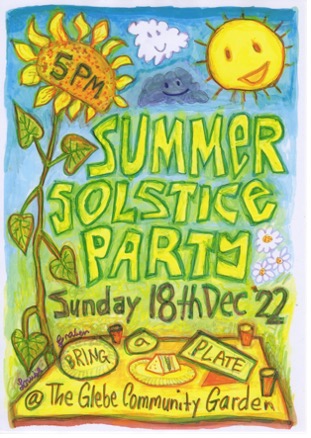
As the year ended, the garden celebrated the joy of summer through a vibrant Summer Solstice Party, a testament to the community spirit. We thank you Louise for the awesome invitation.
A decade of Sunflowers –
This striking flower has gained itself a stronghold in our garden and lent itself to the development of annual communal garden rituals of harvesting, dying the seeds purple and drying the seeds which rotate into the next year’s crop or get consumed.

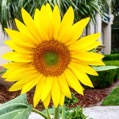
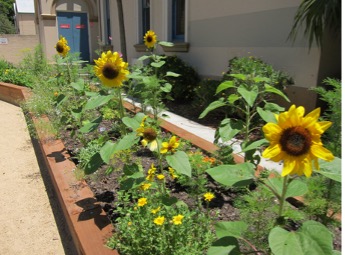






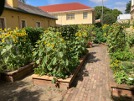

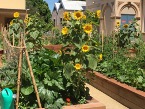
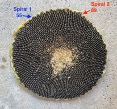
An opportunity for a maths class using sunflowers.
Fibonacci was a famous Italian mathematician of the Middle Ages (13th C). He discovered a sequence of numbers that appear in many plants and other natural systems. Sunflowers are just one example. A sunflower head contains many spirals of seeds to the left and many to the right. If you count the number of spirals to the left and the number to the right the result will correspond to adjacent numbers in the Fibonacci sequence: 1, 2, 3, 5, 8, 13, 21, 34, 55, 89, 144 etc. (each number is the sum of the two previous numbers, and it plots as a spiral). Using one of our sunflower heads I counted the number of spirals to the right and, low and behold, they came to 55. I then counted the number of spirals to the left and they came to 89! Fibonacci is a hero (along with sunflowers). Sunflowers do it because it is the most efficient way to pack their seeds.
